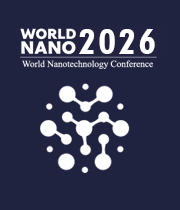Paulo Cesar De Morais, Catholic University of Brasilia, Brazil
The presentation will be focused on exploring mathematical models which are suitable to describe cargo-delivery using nanomaterials (NMs) while assessing information from in vitro assays. Presently, less than about 0.5% of the accumulated world’s reports involving in vitro [....] » Read More





























Title : Safety management for nanomaterials in research environments
Thierry Meyer, EPFL, Switzerland
Health and safety experts face an ongoing challenge in evaluating the risks linked to the increasing utilization of engineered nanomaterials (ENM) in research. Given the constantly changing characteristics of these materials, there is a scarcity of information regarding their tox [....] » Read More
Title : Pentacyclic triterpenoid nano formulations as bioavailable drug delivery agents at cellular level
Carmen Socaciu, BIODIATECH- Proplanta SRL, Romania
The last decade an increasing scientific interest was focused on pentacyclic triterpenoids (betulin, betulinic acid and lupane), considering their antitumor effects without so many secondary adverse actions comparative to other synthetic anticarcinogens (e.g. Doxorubicin). Consid [....] » Read More
Title : Antimicrobial properties of functionalized copper nanoparticles doped with gold nanoclusters
Etelka Chung, University of Hertfordshire, United Kingdom
Nanoparticles are referred to materials with dimensions typically between 1 to 100 nm. It has been found that these materials have enhanced properties, such as antimicrobial activity, due to their large surface area to volume ratio. The conditions during the synthesis of nanopart [....] » Read More
Title : Non-destructive evaluation technique for assessing nanoparticle dispersion in composite materials
Antonio Pantano, University of Palermo, Italy
Extensive production of polymer composites reinforced by nanoparticles is hindered by the lack of non-destructive evaluation (NDE) methods capable of ensuring product quality and compliance with specifications. It is widely recognized that the dispersion level of nanoparticles in [....] » Read More
Title : Functional surface films for individual reconstructive implant in maxillofacial surgery
Igor Reshetov, Sechenov University, Russian Federation
Trauma, disorders, oncology in head and neck organs have growing level . Actually to make reconstructive technologies for restoration this main region of human body. But metals and alloys meet many of these requirements, and the bond strength between the implant and the bone is i [....] » Read More
Title : Photodynamic inactivation of antibiotic-resistant microflora using photosensitizer nanoforms
Igor Reshetov, Sechenov University, Russian Federation
Purulent wounds treatment of soft tissues is associated with certain difficulties, which are caused by multiple factors, including occurrence, formation and wound nature specificities. Purulent complications significantly increase a treatment time and a process cost. We propose t [....] » Read More
Title : Functionalization of Dextrin-capped gold nanoparticles with Oligodeoxynucleotides
Flora Maitim Yrad, Silliman University, Philippines
Gold nanoparticle (AuNP) is a colloidal zerovalent nanoscale gold core generally capped by organic layer and dispersed in a solvent. Their unique properties offer great potential applications in many fields including biosensing. DNA-functionalized AuNPs are popular in [....] » Read More
Title : Manipulation and analysis of large DNA molecules using micro/nanogap structures
Naoki Azuma, Nagoya University, Japan
Analyzing the length of DNA molecules is one of the fundamental processes for analyzing DNA molecules of bacteria and viruses in the human bodies and in the environment. For example, to identify the genotype of bacteria, analyzing the length distribution of DNA fragments is requi [....] » Read More
Title : Development of nitrogen-doped graphene/MOF nanocomposites towards adsorptive removal of Cr (VI) from the wastewater of the herbert bickley treatment works
Tshireletso M Madumo, University of Johannesburg, South Africa
Industrial effluents laden with Cr (VI) pose considerable health risks to human and animal life if left untreated. Hence, in this work, metal–organic framework-5/nitrogen-doped graphene (MOF5/NGO) nanocomposites are fabricated. These materials were produced with increa [....] » Read More
Title : Atomic migration-driven metal nanowire growth
Yasuhiro Kimura, Nagoya University, Japan
Metallic nanowires, also called whiskers, are next-generation materials that are expected to revolutionize the functionality of materials by improving the performance of existing devices due to their unique physical properties at their own microscopic scale. The application of me [....] » Read More
Title : Development and characterization of controlled release nano-fertilizer
Ashita Anand, TERI Deakin Nanobiotechnology Centre, India
Slow-release nano-fertilizers are now utilized widely to enhance nutrient usage efficiency and limit nutrient loss to the environment, which is a major drawback associated with conventional fertilizer applications. In this study, we report the development of a slow-release, macro [....] » Read More
Title : Differential pulse voltammetric tuning of the screenprinted carbon electrode surface to enhance the electrochemical performance and multiplex detection
Mohammad Al Mamun, University of Malaya, Malaysia
Screen-Printed Carbon Electrodes (SPCEs) have shown tremendous scope for the miniaturization and commercialization of low-cost electrochemical sensors and biosensor devices. But the commercial SPCEs have a narrow Potential Window (PW) that limits their applications for various an [....] » Read More
Title : Nanocarriers for the delivery of quercetin to inhibit the UV-induced aggregation of ?D-crystallin
Vishakha Goswami, Indian Institute of Technology, India
Due to gradual environmental changes like ozone layer depletion and global warming, human eyes get exposed to UV light. Exposure to UV light can be a cause of cataract, one of the ocular diseases which may cause vision impairment. To date, lens replacement is the only treatment a [....] » Read More
Title : Design of ion current and fluorescence dual-signal nanochannel sensors for effective and reliable detection
Lu Zhou, University of Macau, China
Nanochannel sensors show high sensitivity and are promising for the detection of toxic substance, biomolecules, and other analytes. However, ion current may be affected by many other factors, leading to false-positive signals. In contrast to the conventional passive reaction to a [....] » Read More
Title : The development of chitosan-based nano-carrier for highly antibiotic resistant H. pylori eradication therapy
Cheng Jung Yao, National Taiwan University, Taiwan
Helicobacter pylori infection usually causes gastrointestinal complications, including gastrointestinal bleeding or perforation, and serious infections may lead to gastric cancer. Amoxicillin is used to treat numerous bacterial infections but is easily decomposed in the gastric a [....] » Read More